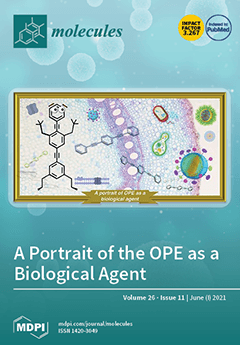Lupin seeds can represent a valuable source of phenolics and other antioxidant compounds. In this work, a comprehensive analysis of the phytochemical profile was performed on seeds from three
Lupinus species, including one cultivar (
Lupinus albus) and two wild accessions (
[...] Read more.
Lupin seeds can represent a valuable source of phenolics and other antioxidant compounds. In this work, a comprehensive analysis of the phytochemical profile was performed on seeds from three
Lupinus species, including one cultivar (
Lupinus albus) and two wild accessions (
Lupinus cossentinii and
Lupinus luteus), collected from the northern region of Tunisia. Untargeted metabolomic profiling allowed to identify 249 compounds, with a great abundance of phenolics and alkaloids. In this regard, the species
L. cossentinii showed the highest phenolic content, being 6.54 mg/g DW, followed by
L. luteus (1.60 mg/g DW) and
L. albus (1.14 mg/g DW). The in vitro antioxidant capacity measured by the ABTS assay on seed extracts ranged from 4.67 to 17.58 mg trolox equivalents (TE)/g, recording the highest values for
L. albus and the lowest for
L. luteus. The DPPH radical scavenging activity ranged from 0.39 to 3.50 mg TE/g. FRAP values varied between 4.11 and 5.75 mg TE/g. CUPRAC values for lupin seeds ranged from 7.20 to 8.95 mg TE/g, recording the highest for
L. cossentinii. The results of phosphomolybdenum assay and metal chelation showed similarity between the three species of
Lupinus. The acetylcholinesterase (AChE) inhibition activity was detected in each methanolic extract analyzed with similar results. Regarding the butyrylcholinesterase (BChE) enzyme, it was weakly inhibited by the
Lupinus extracts; in particular, the highest activity values were recorded for
L. albus (1.74 mg GALAE/g). Overall, our results showed that
L. cossentinii was the most abundant source of polyphenols, consisting mainly in tyrosol equivalents (5.82 mg/g DW). Finally, significant correlations were outlined between the phenolic compounds and the in vitro biological activity measured, particularly when considering flavones, phenolic acids and lower-molecular-weight phenolics.
Full article






